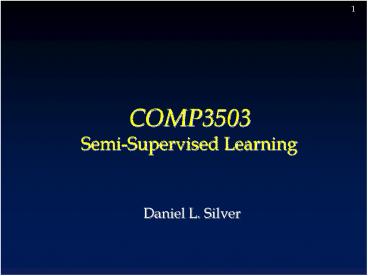COMP3503 Semi-Supervised Learning - PowerPoint PPT Presentation
Title:
COMP3503 Semi-Supervised Learning
Description:
COMP3503 Semi-Supervised Learning Daniel L. Silver – PowerPoint PPT presentation
Number of Views:135
Avg rating:3.0/5.0
Title: COMP3503 Semi-Supervised Learning
1
COMP3503 Semi-Supervised Learning
- Daniel L. Silver
2
Agenda
- Unsupervised Supervised Semi-supervised
- Semi-supervised approaches
- Co-Training
- Software
3
DARPA Grand Challenge 2005
- Stanfords Sebastian Thrun holds a 2M check on
top of Stanley, a robotic Volkswagen Touareg R5 - 212 km autonomus vehicle race, Nevada
- Stanley completed in 6h 54m
- Four other teams also finished
- Great TED talk by him on Driverless cars
- Further background on Sebastian
4
Unsupervised Supervised Semi-supervised
- Sebastian Thrun on Supervised, Unsupervised and
Semi-supervised learning - http//www.youtube.com/watch?vqkcFRr7LqAw
5
Labeled data is expensive
6
Semisupervised learning
- Semisupervised learning attempts to use
unlabeled data as well as labeled data - The aim is to improve classification performance
- Why try to do this? Unlabeled data is often
plentiful and labeling data can be expensive - Web mining classifying web pages
- Text mining identifying names in text
- Video mining classifying people in the news
- Leveraging the large pool of unlabeled examples
would be very attractive
7
How can unlabeled data help ?
8
Clustering for classification
- Idea use naïve Bayes on labeled examples and
then apply EM - 1. Build naïve Bayes model on labeled data
- 2. Label unlabeled data based on class
probabilities (expectation step) - 3. Train new naïve Bayes model based on all the
data (maximization step) - 4. Repeat 2nd and 3rd step until convergence
- Essentially the same as EM for clustering with
fixed cluster membership probabilities for
labeled data and clusters classes - Ensures finding model parameters that have equal
or greater likelihood after each iteration
9
Clustering for classification
- Has been applied successfully to document
classification - Certain phrases are indicative of classes
- e.g supervisor and PhD topic in graduate
student webpage - Some of these phrases occur only in the
unlabeled data, some in both sets - EM can generalize the model by taking advantage
of co-occurrence of these phrases - Has been shown to work quite well
- A bootstrappng procedure from unlabeled to
labeled - Must take care to ensure feedback is positive
10
Also known as Self-training ..
11
Also known as Self-training ..
12
Clustering for classification
- Refinement 1
- Reduce weight of unlabeled data to increase
power of more accuracte labeled data - During Maximization step, maximize weighting of
labeled examples - Refinement 2
- Allow multiple clusters per class
- Number of clusters per class can be set by
cross-validation .. What does this mean ??
13
Generative Models
- See Xiaojin Zhu slides p. 28
14
Co-training
- Method for learning from multiple views
(multiple sets of attributes), eg classifying
webpages - First set of attributes describes content of web
page - Second set of attributes describes links from
other pages - Procedure
- Build a model from each view using available
labeled data - Use each model to assign labels to unlabeled data
- Select those unlabeled examples that were most
confidently predicted by both models (ideally,
preserving ratio of classes) - Add those examples to the training set
- Go to Step 1 until data exhausted
- Assumption views are independent this reduces
the probability of the models agreeing on
incorrect labels
15
Co-training
- Assumption views are independent this reduces
the probability of the models agreeing on
incorrect labels - On datasets where independence holds experiments
have shown that co-training gives better results
than using a standard semi-supervised EM approach - Whys is this ?
16
Co-EM EM Co-training
- Like EM for semisupervised learning, but view is
switched in each iteration of EM - Uses all the unlabeled data (probabilistically
labeled) for training - Has also been used successfully with neural
networks and support vector machines - Co-training also seems to work when views are
chosen randomly! - Why? Possibly because co-trained combined
classifier is more robust than the assumptions
made per each underlying classifier
17
Unsupervised Supervised Semi-supervised
- Sebastian Thrun on Supervised, Unsupervised and
Semi-supervised learning - http//www.youtube.com/watch?vqkcFRr7LqAw
18
Example Object recognition results from
tracking-based semi-supervised learning
- http//www.youtube.com/watch?v9i7gK3-UknU
- http//www.youtube.com/watch?vN_spEOiI550
- Video accompanies the RSS2011 paper
"Tracking-based semi-supervised learning". - The classifier used to generate these results was
trained using 3 hand-labeled training tracks of
each object class plus a large quantity of
unlabeled data. - Gray boxes are objects that were tracked in the
laser and classified as neither pedestrian,
bicyclist, nor car. - The object recognition problem is broken down
into segmentation, tracking, and track
classification components. Segmentation and
tracking are by far the largest sources of error. - Camera data is used only for visualization of
results all object recognition is done using the
laser range finder.
19
Software
- WEKA version that does semi-supervised learning
- http//www.youtube.com/watch?vsWxcIjZFGNM
- https//sites.google.com/a/deusto.es/xabier-ugarte
/downloads/weka-37-modification - LLGC - Learning with Local and Global Consistency
- http//research.microsoft.com/en-us/um/people/denz
ho/papers/LLGC.pdf
20
References
- Introduction to Semi-Supervised Learning
- http//pages.cs.wisc.edu/jerryzhu/pub/sslicml07.p
df - Introduction to Semi-Supervised Learning
- http//mitpress.mit.edu/sites/default/files/titles
/content/9780262033589_sch_0001.pdf
21
THE ENDdanny.silver_at_acadiau.ca































